#future of space technology
Explore tagged Tumblr posts
Text
Breakthroughs in Space Technology: What’s on the Horizon?
Introduction
Space technology has always captured our imagination, pushing the boundaries of what is possible. As we venture further into the cosmos, remarkable breakthroughs are paving the way for new discoveries and advancements. In this article, TechtoIO delves into the exciting world of space technology, highlighting the latest innovations and what’s on the horizon for space exploration. Read to continue link
#Innovation Insights#Tagsadvanced propulsion systems#AI in space#colonizing other planets#commercial spaceflight#future of space technology#interstellar exploration#Mars missions#miniaturized satellites#moon missions#private space companies#radiation protection in space#reusable rockets#space debris solutions#space exploration#space technology#space technology breakthroughs#space tourism#space-based solar power#sustainable space exploration#Trends#Nvidia Drive#Analysis#Tech news#Science updates#Digital advancements#Tech trends#Science breakthroughs#Data analysis#Artificial intelligence
1 note
·
View note
Text
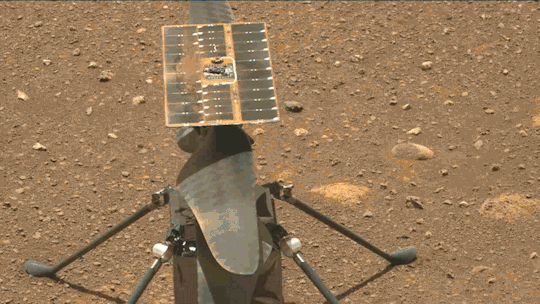
What We Learned from Flying a Helicopter on Mars
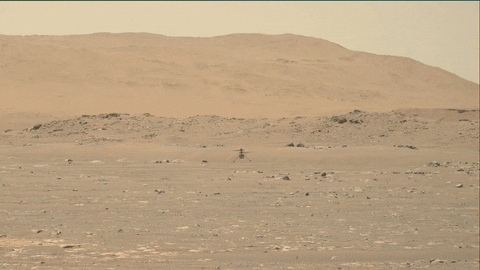
The Ingenuity Mars Helicopter made history – not only as the first aircraft to perform powered, controlled flight on another world – but also for exceeding expectations, pushing the limits, and setting the stage for future NASA aerial exploration of other worlds.
Built as a technology demonstration designed to perform up to five experimental test flights over 30 days, Ingenuity performed flight operations from the Martian surface for almost three years. The helicopter ended its mission on Jan. 25, 2024, after sustaining damage to its rotor blades during its 72nd flight.
So, what did we learn from this small but mighty helicopter?
We can fly rotorcraft in the thin atmosphere of other planets.
Ingenuity proved that powered, controlled flight is possible on other worlds when it took to the Martian skies for the first time on April 19, 2021.
Flying on planets like Mars is no easy feat: The Red Planet has a significantly lower gravity – one-third that of Earth’s – and an extremely thin atmosphere, with only 1% the pressure at the surface compared to our planet. This means there are relatively few air molecules with which Ingenuity’s two 4-foot-wide (1.2-meter-wide) rotor blades can interact to achieve flight.
Ingenuity performed several flights dedicated to understanding key aerodynamic effects and how they interact with the structure and control system of the helicopter, providing us with a treasure-trove of data on how aircraft fly in the Martian atmosphere.
Now, we can use this knowledge to directly improve performance and reduce risk on future planetary aerial vehicles.
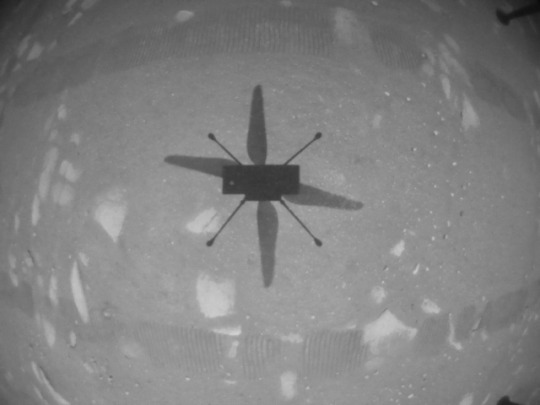
Creative solutions and “ingenuity” kept the helicopter flying longer than expected.
Over an extended mission that lasted for almost 1,000 Martian days (more than 33 times longer than originally planned), Ingenuity was upgraded with the ability to autonomously choose landing sites in treacherous terrain, dealt with a dead sensor, dusted itself off after dust storms, operated from 48 different airfields, performed three emergency landings, and survived a frigid Martian winter.
Fun fact: To keep costs low, the helicopter contained many off-the-shelf-commercial parts from the smartphone industry - parts that had never been tested in deep space. Those parts also surpassed expectations, proving durable throughout Ingenuity’s extended mission, and can inform future budget-conscious hardware solutions.

There is value in adding an aerial dimension to interplanetary surface missions.
Ingenuity traveled to Mars on the belly of the Perseverance rover, which served as the communications relay for Ingenuity and, therefore, was its constant companion. The helicopter also proved itself a helpful scout to the rover.
After its initial five flights in 2021, Ingenuity transitioned to an “operations demonstration,” serving as Perseverance’s eyes in the sky as it scouted science targets, potential rover routes, and inaccessible features, while also capturing stereo images for digital elevation maps.
Airborne assets like Ingenuity unlock a new dimension of exploration on Mars that we did not yet have – providing more pixels per meter of resolution for imaging than an orbiter and exploring locations a rover cannot reach.
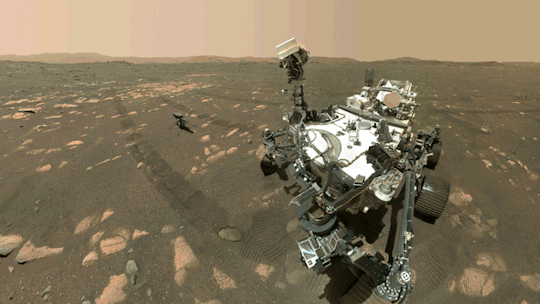
Tech demos can pay off big time.
Ingenuity was flown as a technology demonstration payload on the Mars 2020 mission, and was a high risk, high reward, low-cost endeavor that paid off big. The data collected by the helicopter will be analyzed for years to come and will benefit future Mars and other planetary missions.
Just as the Sojourner rover led to the MER-class (Spirit and Opportunity) rovers, and the MSL-class (Curiosity and Perseverance) rovers, the team believes Ingenuity’s success will lead to future fleets of aircraft at Mars.
In general, NASA’s Technology Demonstration Missions test and advance new technologies, and then transition those capabilities to NASA missions, industry, and other government agencies. Chosen technologies are thoroughly ground- and flight-tested in relevant operating environments — reducing risks to future flight missions, gaining operational heritage and continuing NASA’s long history as a technological leader.
youtube
You can fall in love with robots on another planet.
Following in the tracks of beloved Martian rovers, the Ingenuity Mars Helicopter built up a worldwide fanbase. The Ingenuity team and public awaited every single flight with anticipation, awe, humor, and hope.
Check out #ThanksIngenuity on social media to see what’s been said about the helicopter’s accomplishments.
youtube
Learn more about Ingenuity’s accomplishments here. And make sure to follow us on Tumblr for your regular dose of space!
5K notes
·
View notes
Text

Control is not convinced
That the computer
Has the evidence
190 notes
·
View notes
Text

The Lick telescope, length 57 feet (17.37 m), diameter of object glass 36 inches (91.4cm), total weight 40 tons (33,000kg). Published: Cleveland, O. : W.J. Morgan & Co. Lith., c1889 April 8.
553 notes
·
View notes
Text

The New Millennium in your Hands
#art#nostalgia#1980s#vaporwave#aesthetic#vintage#magazine#1990s#neon#space#retrowave#retro cgi#retro tech#technology#tech#illustration#nature#amiga#retro computing#computer science#computers#computer#software#future#scifi#80s style#80s aesthetic#80s#90s#90s aesthetic
360 notes
·
View notes
Text









Alien vs Predator
It's time to pick a side.
#moodboard#mine#movie moodboard#horror#the alien series#alien vs predator#AVP#AVP 2004#alien#aliens#predator#predators#the predator#movies#tech#techno#body tech#cyber#futurism#space#synthetic#robotics#technology#pottery#creatures
27 notes
·
View notes
Text



admiralty st.
#liminal spaces#liminal#dreamy#dreamcore#dream situation#nights into dreams#underground#subway#architectural details#modern architecture#architecture photography#eeriecore#eerie aesthetic#cinestill800t#cineshots#cinematicart#cinematic photography#cinestill#technology#cyberpunk photography#futuristic#futurism#cyberpunk photomode#cyberspace#techcore#tech#cyberpunk#sony a7iii#sony photography#hong kong
20 notes
·
View notes
Text

1999 - TDK XS-iV Design Line L.E. Devrialem MD74
#99#90s#1999#1990s#art#blue#cd#cybercore#cyber y2k#design#earth#electronic#future#futuristic#futurism#graphic design#graphics#green#illustration#kaybug#minidisc#photography#space#tdk#tech#technology#y2kcore#y2kore#y2k aesthetic#y2k art
72 notes
·
View notes
Text
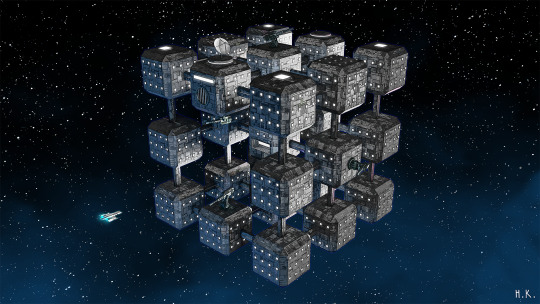
Modular Station, Digital artwork, 2025
#art#artists on tumblr#artwork#scifi art#digitalart#scifi#science fiction#space art#space#station#space station#spaceship#modular#modules#technology art#technology#futurism#futuristic
14 notes
·
View notes
Text

Astronomers have discovered record-breaking wind speeds of up to 33,000 km/h on WASP-127b, a gas giant 520 light years away. These winds, moving six times faster than the planet's rotation, are the fastest ever observed on any planet.
𝐀𝐛𝐨𝐮𝐭 𝐖𝐀𝐒𝐏-𝟏𝟐𝟕𝐛:
A hot Jupiter, 30% larger than Jupiter but with low density
Orbits its star in just 4 days, causing extreme temperature differences
Atmosphere contains hydrogen, helium, carbon monoxide, and water
With searing temperatures of 1,127°C, WASP-127b remains an exoplanet of extreme and fascinating conditions.
#general knowledge#affairsmastery#generalknowledge#current events#current news#upscaspirants#upsc#generalknowledgeindia#upsc current affairs#upscpreparation#upsc2025#iaspreparation#upsccoaching#breaking news#world news#news#technology#outer space#space#planet#astronomy#galaxy#cosmos#solar system#jupiter#discovery#discover#exploration#future#explore
17 notes
·
View notes
Text
hey so i did another thing

#lowkey im proud of this one?#it took my one sitting which i was impressed by (2 hours btw)#lowkey i was surprised that the hand didn't turn out horrific#the hair did but fuck it we ball#i discovered my art style: sketchy af#also i started out thinking that i could do colour theory but it just ended up green#green like my broccoli boy fr#tried to rely less on the technology and lowkey it helped#i used less layers and tried to zoom in less (i've been reading all the tips my fav mha artists gave haha) and i think it helped#like i tried to be more natural#and it worked? idk#learnt things about shading for sure#found a new brush i liked too!!#for my future reference im gonna say it was the one at the very bottom bc ik im gonna forget at some point and come looking here#idk man the more i stare at it the worse it gets#but yeah posting this here as a lil log of my art works hehe#im no artiste that's for sure#deku#space boo art#mha
11 notes
·
View notes
Text

The Implications of UFO Disclosure: A New Era for Human Society
The conversation between Jeffrey Mishlove and Daniel Sheehan on UFO disclosure, extraterrestrial life, and the implications for human society raises important questions about the need for transparency and accountability in the face of potentially paradigm-shifting revelations. As the discussion highlights, recent statements from prominent figures have contributed to a growing momentum towards acknowledging the reality of UFOs and extraterrestrial life. However, this shift towards transparency also raises concerns about the potential exploitation of this knowledge by private aerospace corporations and the need for a unified approach to establishing relations with extraterrestrial entities.
A critical examination of the conversation reveals that the acknowledgment of telepathy and other forms of extrasensory perception has significant implications for our understanding of human consciousness and the nature of reality. While some may argue that these phenomena challenge materialist worldviews and fundamental principles of legal systems, a more nuanced analysis suggests that they also highlight the complexity and multifaceted nature of human experience. The role of spiritual and religious communities in guiding humanity's response to extraterrestrial life is also a crucial aspect of the discussion, as it underscores the need for a compassionate and inclusive approach that recognizes the diversity of human experiences and perspectives.
The conversation between Mishlove and Sheehan also touches on the topic of private sector involvement in UFO research and the potential risks associated with this development. As private aerospace corporations become increasingly involved in the search for extraterrestrial life, there is a growing concern that their primary motivation may be to exploit this knowledge for commercial gain, rather than to advance our understanding of the universe and its inhabitants. This raises important questions about the need for regulatory frameworks and oversight mechanisms to ensure that private sector involvement in UFO research is transparent, accountable, and aligned with the public interest.
Furthermore, the discussion highlights the importance of a unified approach to establishing relations with extraterrestrial entities. As the possibility of extraterrestrial life becomes increasingly plausible, it is essential that nations and governments work together to develop a coordinated response to this phenomenon. This will require a high degree of cooperation and diplomacy, as well as a willingness to set aside national interests and prioritize the well-being of humanity as a whole. The establishment of formal protocols or treaties between governments and extraterrestrial entities may also be necessary, raising complex questions about the nature of sovereignty, jurisdiction, and the rule of law in the context of interstellar relations.
The implications of UFO disclosure and extraterrestrial life for human society are far-reaching and multifaceted, and will require a thoughtful and nuanced approach to navigate. One of the most significant challenges will be to reconcile the existence of extraterrestrial life with our current understanding of the universe and our place within it. This may require a fundamental shift in our worldview, as we come to terms with the possibility that we are not alone in the universe, and that our planet is part of a larger cosmic ecosystem. The acknowledgment of telepathy and other forms of extrasensory perception will also require a re-evaluation of our understanding of human consciousness and the nature of reality, and may challenge traditional notions of space, time, and causality.
The role of spiritual and religious communities in guiding humanity's response to extraterrestrial life will be crucial in this context. As people struggle to make sense of this new reality, they will turn to spiritual and religious leaders for guidance and support. It is essential that these leaders are prepared to provide a compassionate and inclusive response, one that recognizes the diversity of human experiences and perspectives, and acknowledges the complexity and multifaceted nature of human consciousness. This will require a high degree of sensitivity and empathy, as well as a willingness to engage with the scientific and philosophical implications of UFO disclosure and extraterrestrial life.
The conversation between Jeffrey Mishlove and Daniel Sheehan serves as a reminder that the implications of UFO disclosure and extraterrestrial life are far-reaching and multifaceted, requiring a thoughtful and nuanced approach that takes into account the complex interplay between technology, spirituality, and human society. By engaging with these issues in a careful and evidence-based manner, we can work towards a deeper understanding of the profound implications of extraterrestrial life for human society and the future of our planet. This will require a willingness to challenge our assumptions and biases, and to embrace the uncertainty and ambiguity that surrounds this phenomenon. However, the potential rewards are significant, and may include a new era of cooperation and collaboration among nations, a deeper understanding of the universe and our place within it, and a more profound appreciation for the complexity and multifaceted nature of human consciousness.
Daniel Sheehan: UFO/UAP Disclosure Milestone (Jeffrey Mishlove, New Thinking Allowed, January 2025)
youtube
Daniel Sheehan's worldview, as reflected in his conversation with Jeffrey Mishlove, presents a fascinating and complex perspective on the nature of human society, technology, and spirituality. His emphasis on transparency, cooperation, and spiritual awareness appears to be a refreshing and much-needed antidote to the dominant ideologies of neoliberalism and nationalism, which often prioritize individualism, competition, and the interests of powerful nations and corporations over the well-being of the planet and its inhabitants. However, upon closer examination, it becomes clear that Sheehan's worldview is not without its challenges and criticisms, and that his ideas must be carefully considered in the context of the real political situation in the world.
The idea of a unified and cooperative human society, as envisioned by Sheehan, is undoubtedly appealing, but it is difficult to imagine how this could be achieved in practice, particularly in the absence of a shared sense of purpose or a common enemy to unite against. The world is a messy and often brutal place, where nations and ideologies clash, and competing interests and power struggles are a constant reality. Furthermore, Sheehan's spiritually-informed perspective, while intriguing and thought-provoking, may be seen as too vague or abstract by some, and insufficiently grounded in the concrete realities of political and economic power.
Despite these challenges and criticisms, Sheehan's worldview remains an important and timely contribution to the ongoing conversation about the nature of human society and our place in the universe. His emphasis on transparency, cooperation, and spiritual awareness serves as a powerful reminder of the need for a more holistic and integrated understanding of the world, one that recognizes the interconnectedness of all things and the importance of individual and collective well-being. This perspective is in stark contrast to the dominant ideologies of neoliberalism and nationalism, which often prioritize the interests of powerful nations and corporations over the well-being of the planet and its inhabitants.
In many ways, Sheehan's worldview can be seen as a form of progressive, spiritually-informed, and cosmically-aware liberalism, which prioritizes the values of cooperation, mutual understanding, and the protection of individual rights and freedoms. This perspective is rooted in a deep understanding of the complex and multifaceted nature of human society, and recognizes the need for a more nuanced and sophisticated approach to addressing the challenges and complexities of the modern world. By emphasizing the importance of transparency, cooperation, and spiritual awareness, Sheehan's worldview offers a powerful alternative to the dominant ideologies of neoliberalism and nationalism, and provides a vision for a more just, equitable, and sustainable future.
The value and relevance of Sheehan's worldview will depend on the specific context and the perspectives of those engaging with his ideas. While his emphasis on cooperation, transparency, and spiritual awareness may be seen as overly idealistic or naive by some, it remains an important and timely contribution to the ongoing conversation about the nature of human society and our place in the universe. As we navigate the complex and often challenging landscape of global politics and international relations, Sheehan's worldview offers a powerful reminder of the need for a more holistic and integrated understanding of the world, one that recognizes the interconnectedness of all things and the importance of individual and collective well-being. By engaging with Sheehan's ideas and considering their implications for our understanding of the world, we may be able to develop a more nuanced and sophisticated approach to addressing the challenges and complexities of the modern world, and to create a more just, equitable, and sustainable future for all.
Saturday, February 22, 2025
#ufo disclosure#extraterrestrial life#human society#technology#spirituality#consciousness#space exploration#alien life#future of humanity#cosmic context#interview#ai assisted writing#machine art#Youtube
13 notes
·
View notes
Text

These guys passed their exams with flying colors and are now ready to colonize a new planet
8 notes
·
View notes
Text

BB 80G
#cars#sports cars#future#energy#automobile#automotive#car photography#spaceship#space station#space travel#technology#computing#futurism#sports car racing#cyberpunk art#cybernetics#cyberpunk
8 notes
·
View notes
Text

60 notes
·
View notes
Text
Air Wonder Stories, (Gernsback, 1929-30). It was an American science fiction magazine published in 1929 and 1930 by Hugo Gernsback.

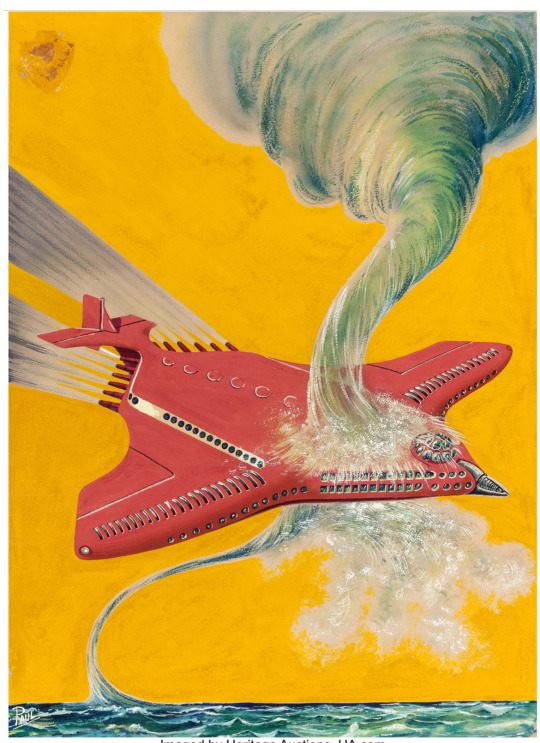

#futurism#illustration#science fiction#space#technology#trains#ships#1920s#1930s#vintage#graphic art#comics#pop culture
31 notes
·
View notes